FREE Standard Shipping On All Orders $100 or More!*
How to Change Pool Filter Sand
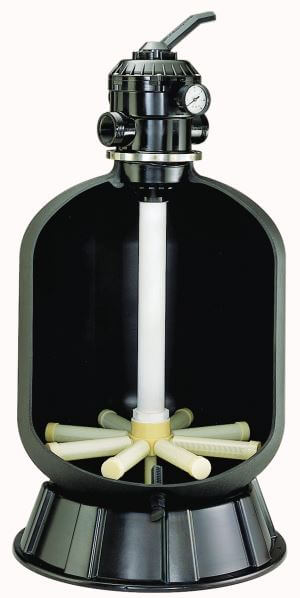
Today I’m going to discuss how to change your pool filter sand, but before I do, I should probably explain why it needs to be changed.
Over time as water rushes through the filter, the jagged edges of the sand which help to trap debris will wear down and become smooth. When this happens the sand can no longer trap debris particles and dirt can pass through the sand and back into the pool.
If your pool water chemistry is balanced, the sand filter is properly sized and running the proper length of time (8-10 hours a day), and the bather load is normal, but the water will not clear up even if you use a clarifier — change the sand.

If your water quality is suffering, I would recommend trying a sand filter cleaner first, especially if the filter is fairly new or you recently changed the sand. Filter cleaner such as Natural Chemistry’s Filter Perfect will remove oils, grease and scum that can build up in the filter over time and won’t be removed by backwashing alone. If the filter pressure continues to run high even after backwashing and using a filter cleaner, the sand should be changed.
Most manufacturers’ recommend that the sand be changed every 5-7 years, but your time frame could be a bit longer or shorter depending on water clarity and the size of your sand filter. 5-7 years is a good guideline, but focus on the performance of the filter, or the water clarity rather than changing the sand on a set schedule.
Filter Sand and Filter Sand Alternatives
Make sure you have the correct amount of filter sand or filter sand alternative (which I’ll discuss in a moment) on hand before you start the change process. Check your sand filter label or manual to discover how much sand is needed.
The only sand appropriate for use in swimming pool filters is #20 silica sand, which is .45-.55mm in size. Do not substitute any other kind of sand; it will not work properly.
If you would like to increase your filter’s cleaning power, consider pool filter sand alternatives, like ZeoSand or FilterGlass. ZeoSand is made of a high purity, natural mineral called zeolite that has a surface area 100 times greater than sand, allowing smaller particles to be trapped, which improves water clarity and increases the time between backwashing.

ZeoSand is installed in generally the same manner as sand, but you can use 50% less ZeoSand than standard pool filter sand. So, if your filter usually requires 300lbs of sand, you will use 150lbs of ZeoSand.
FilterGlass is made of finely crushed recycled glass. The glass particles are smooth to the touch and each piece is uniquely shaped making it less likely to channel as silica sand can over time. FilterGlass has a slightly negative electrical charge which allows it to hold fine, positively charged particles such as iron and manganese. FilterGlass removes particles as small as 2-5 microns and you can use about 20% less than you would sand.
Changing Pool Filter Sand
Step 1: Remove the Old Sand
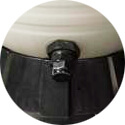
Before you begin working with the filter you must turn off your pump and disconnect power to the pump at the circuit breaker. Next, drain the water from the filter. There will be a drain cap or plug at the bottom of the filter that you can remove to allow the water to drain out. When the water finishes draining you can begin taking apart the filter to remove the old sand.
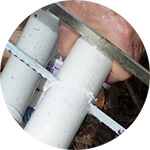
Filters with the multiport valve mounted on top (which will be the case for most residential filters will require that you disconnect the plumbing running to the valve. If you use PVC pipes and do not have unions on these pipes, you will need to cut the pipe to remove the multiport valve. I would recommend that you install unions when you put the filter back together to allow for easier service to the filter in the future.
Filters with the multiport valve mounted to the side will have a dome or access port on top that can be removed get inside of the tank. Move the diffuser to one side to gain access to the sand.
Before you begin removing any sand it is a good idea to use tape, a cup or some other kind of cover to block the opening of the center standpipe inside the filter to prevent sand from entering it. If sand enters the center pipe it could clog the laterals or will at the very least end up back in your pool when you turn the system back on.

To remove the sand from the filter you can either scoop it out with a can or use a wet/dry shop vac. Once you get a good amount of sand removed you may be tempted to just pick up the filter and dump out the rest, but do NOT do this! The plastic laterals at the bottom of the tank could break very easily under the pressure of the sand falling out and being knocked around.
When you reach the point where you can see the laterals at the bottom of the tank, proceed carefully so as not to bump and crack the possibly brittle plastic. On Hayward sand filters, you can remove the laterals and center pipe by pulling up on each lateral to point upwards so you can slide the whole lateral assembly out of the tank.
For other filter brands, you could unscrew each lateral, or just work around the laterals, leaving them in the tank. Most tanks have the ability to remove the entire drain assembly, allowing you to flush out remaining sand with a garden hose. If you end up leaving some sand in the bottom, beneath the laterals, that's no big deal.
Step 2: Clean and Inspect the Filter
Once you have all the old sand removed you will need to clean the filter tank and inspect for any damage. Check each of the laterals for any cracks and replace them if necessary. If they are very old and brittle, it may be wise to replace them all at the same time that you replace the filter sand.

Any crack or break in the laterals could result in sand being deposited in the pool when you turn your filter back on, so if anything looks questionable it is better to just replace the lateral. If you turn your filter back on and end up with sand in the pool you could be redoing this whole process just to change one broken lateral.
If the laterals look very dirty or clogged, you can soak them in a cleaning solution or mild muriatic acid solution to remove any buildup. After you remove them from the solution rinse with a garden hose and rinse out and clean the filter tank. Replace the drain cap that was removed to drain the water at the bottom of the tank.
Step 3: Add New Filter Sand or Sand Alternative
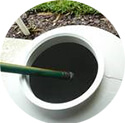
Before you put the lateral assembly back in to the tank, fill the tank about half way full of water. This will help cushion the lateral assembly when you add sand back in to the tank. After adding the water carefully put the lateral assembly in the tank, ensuring that the laterals are tightly screwed into the hub assembly. For laterals that are slotted on one side, face the slotted side downward, or alternate each - half facing up, half facing down.

Be sure that whatever covering you used over the center pipe when you removed the sand is still in place so you do not get sand in the center pipe as you add it to the tank. Silica dust can be hazardous, wear a respiration mask and watch your breathing while adding filter sand.
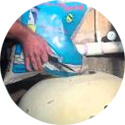
If you have chosen to use a filter sand alternative thoroughly read any instructions to make sure you do not skip any necessary steps for that particular product. Place the bag on top of the tank and slice open the bottom of the bag with a razor knife. Be sure to keep the center pipe straight and fully flat on the bottom throughout the process. If it ends up crooked you may not be able to properly re-install the multiport valve and will have to remove the sand to straighten it.
Step 4: Reassembly and Start Up
Once you have added the amount of sand recommended by the manufacturer, remove the tape/covering you used on the center pipe and install the multiport valve. Reconnect the plumbing to the multiport valve, and if possible, pick up some PVC unions and install to make future filter service easier.
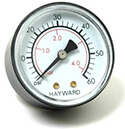
Before resuming normal filtering, backwash and rinse the filter for a few minutes to remove any impurities and sand dust. When the water in the sight glass is clear you are ready to begin normal filtering. Turn the pump off again and change the multiport valve setting to “Filter” and turn the pool pump back on.
Note the reading on the pressure gauge; this is the starting, or clean filter pressure. When you see the pressure 8-10psi over this reading, give the filter a good backwashing.
Most customers report back that changing the sand takes a few hours. As with most tasks, the first time may take you a bit longer, but you’ll know what to expect in the future.